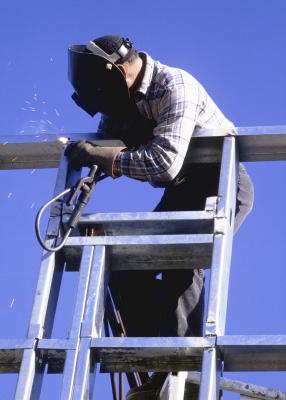
All electrical circuits have a positive and negative pole called polarity. Welding polarity describes the polarity of an electrical current that is produced by a welder at the electrode. Metal electrodes must have the correct polarity, either "straight" or "reverse," to achieve a weld of the correct strength and quality for the given material. Reverse polarity is also called electrode positive, and straight polarity is referred to as electrode negative. A welder should learn the differences in the welding process to determine the correct polarity.
Refer to the American Welding Society Welding Handbook for the proper size electrode and its shielding characteristics. Depending upon the piece or stock to be welded, you must match the correct electrode and polarity setting to accomplish the weld. The electrodes contain a numbering system with letters and digits. For example, EXX10DC+ indicates that this electrode needs DC current and that it will use reverse polarity, or is electrode positive. Another example is EXX12AC or DC-, which means the electrode can be used with AC or DC current and that the polarity is straight, or electrode negative
Determine and identify which welding machine you are using. AC transformer-type welders have electrodes that will function with both straight and reverse polarities, because the polarity fluctuates back and forth rapidly in the AC circuit. If you have AC electrodes that are used on DC current, it will stipulate that only one polarity can be used at a time.
Check the covering or shielding material on the electrode that you need to use. The covering material, like cellulose, for example, will require a specific polarity for its use. Read the instructions on the electrode storage container to determine what polarity is recommended. For example, a high covering of cellulose on a steel rod, like Fleetweld 5P+ or 5P, is used only with reverse polarity in general welding, and the instructions will state this fact.
Study and know the meaning of polarity and how it affects each individual weld. Use reverse polarity for welds where you need deep penetration, such as on painted metals and dirty or rusty surfaces. Reverse polarity uses a much higher heat concentration at the tip of the electrode. DC reverse polarity also uses a larger-diameter electrode than DC straight polarity. Use straight polarity, which has a faster electrode melt-off with a heavier deposition, for shallow welds that require medium penetration.
Examine your welding machine for the position of all switches and control settings. Most welding machines have clear markings to identify the setting on the terminals and come with switches to change the polarity. Determine if you have to manually change the cable terminals to switch the polarity. If in doubt at any time about your polarity setting, perform a test weld with a DC carbon electrode--it will function perfectly with reverse polarity. Or use a Fleetweld 5P electrode, which will show very poor performance on reverse polarity but work exceptionally well on straight polarity.